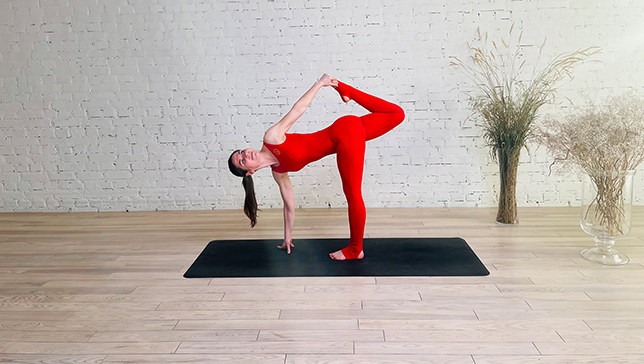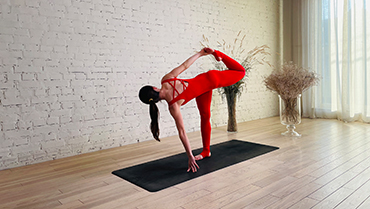Revolved Surarcane Pose - Parivrtta Ardha Chandra Chapasana

Contents
Revolved Sugarcane Pose or Parivrtta Ardha Chandra Chapasana in Sanskrit (Parivrtta means ‘Revolved’, Ardha means ‘half’, Chandra is ‘moon’, Chapa means ‘arc or bow’, and asana means ‘pose’) is an advanced level yoga pose that is performed in a standing position. This is a variation of Revolved Half Moon Pose (Parivrtta Ardha Chandrasana).
Same as in Revolved Half-Moon Pose, Revolved Sugarcane Pose involves torso rotation and opens the chest as you hold your foot from your back. It also works as a hip opener and leg stretching pose at the same time. Being a balancing pose, it also helps to release stress and work on focus and groundedness.
Pose Detail
- Difficulty: Advanced
- Body Position: Arm & Leg Support, Backbend Yoga Poses, Forward Bend Yoga Poses, Twist Yoga Poses
- By Type: Balancing Yoga Poses, Chest Opening Yoga Poses, Flexibility Yoga Poses, Hip Opening Yoga Poses, Shoulder Opening Yoga Poses, Strengthening Yoga Poses
- By Benefit: Yoga Poses For Weight Loss
Step-by-Step Instructions
Benefits and Contraindications
Stretches the shoulders, back and hamstrings
Improves balance and coordination
Improves digestion
Helps to relieve stress
Strengthens the legs and core
Low blood pressure
Insomnia
Diarrhea
Neck injuries
Pregnancy
Photo poses in different angles

Modifications And Props For Beginners
- Use a block, chair, or wheel under your hand that is reaching the mat. This will help you find better stability and thus to feel more confident in the posture.
- If you can’t reach your ankle or foot with your hand, you can use a strap or towel to help you reach.
Revolved Surarcane Pose Anatomy
Here is a small description of how different parts of the body are activated in a pose from an anatomical perspective:
- Legs: The pose requires a strong and active engagement of the standing leg, particularly the quadriceps, hamstrings, and glutes. The lifted leg should be actively flexed and engaged in order to maintain balance.
- Core: The core muscles, including the transverse abdominis, rectus abdominis, and obliques, are engaged to support the spine and maintain balance.
- Spine: The pose involves a deep twist of the spine, particularly in the thoracic spine, which helps to increase spinal mobility and improve digestion.
- Shoulders: The pose requires a strong engagement of the shoulders to maintain stability and balance while twisting. The rotator cuff muscles, including the supraspinatus, infraspinatus, teres minor, and subscapularis, are particularly active in this pose.
- Hips: The hips are involved in this pose to maintain balance and stability. The hip abductors, including the gluteus medius and minimus, are particularly active in stabilizing the pelvis.
- Breathing: The pose requires deep and controlled breathing to help maintain balance and focus. The expansion and contraction of the ribcage during each breath can also help to deepen the twist in the spine.
Frequently Asked Questions
Variations
- Revolved Sugarcane Pose with Wheel
- Revolved Sugarcane Pose with Block
- Revolved Sugarcane Pose with Chair
- Revolved Half Moon Pose
Top Preparatory Poses
Top Follow-Up Poses
- Revolved Lord of the Dance
- Mountain Pose